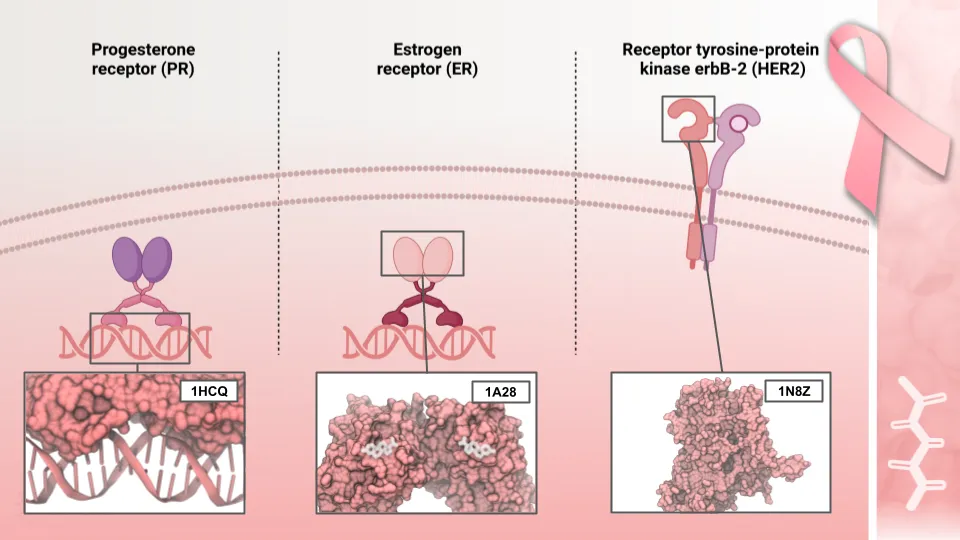Differences in breast cancer through a biochemical lens
October is Breast Cancer Awareness Month. Breast cancer is different for everyone, and this heterogeneity originates from differences in genetics and other features of cancer cells, affecting how tumors grow, spread, and respond to treatment. This article is intended to raise awareness about common types of breast cancer, which help doctors provide more personalized treatments. Advancements in research and technology are paving the way for more effective breast cancer treatments for unique cancer subtypes, offering hope for improved outcomes and a brighter future in the fight against this disease.
Breast cancer is a complex disease that affects millions of individuals worldwide, and it comes in various forms. One crucial aspect of breast cancer classification revolves around the presence or absence of specific receptors on cancer cells. These receptors — HER2, ER, and PR — play a pivotal role in determining the course of the disease and guiding treatment decisions.
In this article, we’ll delve into the different types of breast cancer in relation to these receptors and explore how this knowledge is transforming the way we approach breast cancer treatment.
. . .
HER2, ER, and PR Receptors
HER2 (human epidermal growth factor receptor 2), ER (estrogen receptor), and PR (progesterone receptor) are proteins that are expressed in breast cancer cells. These receptors play crucial roles in how breast cancer cells grow and respond to treatments.

- PR: Progesterone receptors are nuclear receptors (expressed inside the cell) that interact with progesterone, a steroid hormone present in the body. The binding of progesterone can stimulate growth and survival of cancer cells.
- ER: Estrogen receptors are also nuclear receptors (expressed inside the cell), and like PR, they respond to hormones — in this case, estrogen. When estrogen binds to these receptors, it can stimulate cancer cell growth.
- HER2: A transmembrane protein (expressed on the cell surface) that helps breast cancer cells grow quickly. It can be overactive in some breast cancers, causing them to grow more aggressively.
Understanding the presence or absence of these receptors helps doctors determine the most effective treatment strategies — also known as targeted therapy — for each patient’s unique type of breast cancer.
. . .
Hormone Receptor-Positive (HR+) Breast Cancer:
HR+ breast cancers are the most prevalent subtypes of breast cancer according to the National Cancer Institute.
ER-Positive (ER+): When breast cancer cells have estrogen receptors (ER+), it means they can respond to estrogen, a hormone that promotes cell growth. To combat ER+ breast cancer, doctors often employ hormone therapy, such as Tamoxifen or aromatase inhibitors, to block the effects of estrogen and slow down cancer cell growth.
PR-Positive (PR+): Similarly, some breast cancers express progesterone receptors (PR+), which can also fuel cancer growth when progesterone binds to them. Hormone therapy is used to counteract the impact of progesterone in PR+ breast cancer.
ER/PR-Positive (ER+/PR+): In some cases, breast cancers express both ER and PR receptors. These are categorized as ER+/PR+ breast cancers and are typically treated with hormone therapy.
HER2-Positive (HER2+) Breast Cancer:
HER2-Positive (HER2+): HER2 is a protein that can be overexpressed in certain breast cancers. HER2+ breast cancer often grows more aggressively since HER2 is a growth-promoting protein. Targeted therapies, such as Herceptin (trastuzumab) and other HER2 inhibitors, are employed alongside chemotherapy to effectively treat HER2+ breast cancer.
Triple-Negative Breast Cancer (TNBC):
10–15% of breast cancer patients are diagnosed with triple-negative breast cancer. It is more common in women younger than age 40 and it tends to spread faster, currently has no good treatment option and has significantly lower survival rates than other breast cancer subtypes.
Triple-Negative Breast Cancer (TNBC): In this challenging subtype, breast cancer cells lack the expression of all three receptors — ER, PR, and HER2. Since hormone therapies and HER2-targeted treatments are ineffective, treatment options typically revolve around chemotherapy and, in some cases, immunotherapy.
. . .
Breast cancer is a heterogeneous disease, meaning it varies greatly from one patient to another. To provide the most effective treatment, physicians often perform molecular testing, such as genomic sequencing, to gain deeper insights into a patient’s specific subtype of breast cancer.
This personalized approach to treatment is transforming the field of oncology, offering new hope to patients facing a breast cancer diagnosis. As our understanding of breast cancer continues to evolve, so too do the treatment options available to those in need.
. . .
At ProteinQure, we’re dedicated to advancing the fight against breast cancer through cutting-edge research and innovative therapies. ProteinQure‘s first internal drug discovery program focuses on treating triple-negative breast cancer with a novel computationally designed peptide-drug conjugate. Check out our news section if you want to learn more about it. By staying at the forefront of scientific discovery, we aim to provide patients with the best possible treatment options and a brighter outlook on their journey to recovery.
Breast cancer is a challenging adversary, but with knowledge, research, and the right therapies, we’re working together to overcome it. Join us in the fight against breast cancer and help us spread awareness about the importance of HER2, ER, and PR receptors in breast cancer diagnosis and treatment!
All figures were created with BioRender.com and VMD.